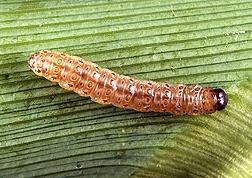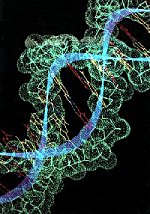
Are you happy to eat genetically modified foods? What about your friends and colleagues? Do the GM pros outweigh the cons?
I asked a few contacts for some answers by way of building up to a more formal response to those kinds of questions that will be published soon in the International Journal of Biotechnology (IJBT, 2008, 10, 240-259).
Plant geneticist Dennis Lee, Director of Research at mAbGen, in Houston, Texas, suggests that GM crops have several significant advantages. “Total cost per acre can actually be significantly less for GM crops,” he says. This is particularly true for crop species, such as maize, that have been modified to produce natural toxins that fend off insect pests or protect the crop from the herbicides need to keep weed growth at a minimum. However, he points out that, “In practice, this is often not the case – farmers tend to err on the side of caution and continue to use significant amounts of pesticides and herbicides.”
That said, crops can also be modified to grow in substandard conditions, such as strains of tubers grown in Kenya that are capable of surviving both drought conditions and high-salt soils. “Obviously, this is beneficial to yield – you can actually get some food out of places where you previously could not,” adds Lee. In addition, it could be possible to modify some crops to have greater nutritional content, such as the so-called “golden rice” project by Ingo Potrykus then at the Institute of Plant Sciences of the ETH Zurich.
One of the biggest perceived problems regarding GM crops is the possible contamination of other species. What if herbicide-resistant genes could jump into weed species, for instance? Lee points out that this putative problem can be overcome by using terminator technology to jumping genes. “However, in doing so, it creates a different problem,” Lee adds, namely that farmers must buy seed from the agbiotech company each year rather than save seed for planting.” One might say that this is an exploitative industry focused purely on maximizing profits, but at the same time it solves a serious technical problem that has been seen as one of the biggest stumbling blocks to the acceptance of GM crops.
Jeff Chatterton, a Risk and Crisis Communications Consultant at Checkmate Public Affairs, in Ottawa, points out that the pros are well documented: increased yield per acre, ease of use and perhaps, some day, increased ‘consumer level’ benefits such as higher nutritional values. But, echoes others’ comments on the hidden con of farmers the world over potentially being locked into the agbiotech company’s seed and having no recourse to produce their own from one year to the next.
“As traditional family farms are increasingly moving towards “Roundup Ready” corn or soybeans, you’re increasingly seeing a change in the business model of farming,” he says. “Rather than ‘family farms’ using traditional farming practices, agricultural operations are increasingly becoming factory farms.” It might be said that the emergence of factory farms is occurring outside the realm of GM crops, but with pressure being applied to produce more and more crops for non-food purposes, including, biofuels, unique polymers, and other products, the notion of a factory farm that doesn’t even feed us could become an increasing reality.
Lee also mentions an intriguing irony regarding the public perception of risk-benefits concerning GM crops and that is that the toxins produced by modified Bt maize is exactly the same toxin produced by the natural soil microbe Bacillus thuringiensis (Bt) itself and this is same Bt toxin that so-called “organic” farmers are usually allowed to use instead of “synthetic” pesticides.
Information Technology and Services Professional Bill Nigh of Bluenog, based in New York, provides perspective as a lay person. “We’ve been engaged in genetic manipulation for a long time now,” he says, “but it was limited by the technology at hand. With recombinant DNA it’s a remarkably more vast field of play and a whole new ball game.” He stresses that his main concern regarding GM crops is that, “We seem to be just smart enough to make drastic breakthroughs and inventions, and are driven by the dynamics of the marketplace and ego to produce a lot of new things quickly. However our systems of governance, oversight and coordination are not mature enough to work through the implications of those new things in a timely fashion, especially the unforeseen synergies the breakthroughs can unleash.”
All that said, an international team has now investigated the various issues and has assessed the public’s Willingness to Accept (WTA) GM foods based on experimental auctions carried out in France, UK, and USA. Lead author of the IJBT paper Wallace Yee now at the University of Liverpool, worked, while at Reading University, with colleagues in various disciplines, from agricultural and food to business and economics in Italy, New Zealand, UK and US to explore perceptions of risk and benefits, moral concerns and attitudes to the environment and technology.
“Trust in information provided by industry proved to be the most important determinant of risk/benefit perceptions,” the researchers conclude, “willingness to accept followed general attitudes to the environment and technology.” They also found that educational level and age could also enhance perceived benefits and lower perceived risks of GM foods. “Our research suggests that trust-building by industry would be the most effective approach to enhancing the acceptance of GM foods,” the team says.
“If the industry could educate people that GM technology does not pose any threat to the environment, but provides benefits to society as a whole and consumers as individuals, the attitudes of the public towards GM in food production would be favourable, and in turn increase their willingness to accept,” they conclude.
Computing professional Paul Boddie of Oslo, Norway, coming at the issue of GM crops from an indirect angle provides an allusion to computer programming that seems quite pertinent and was originally attributed to Brian Kernighan, which Boddie suggests readily transfers to other disciplines including genetic engineering: “Everyone knows that debugging is twice as hard as writing a program in the first place. So if you are as clever as you can be when you write it, how will you ever debug it?”
Yee, W.M., Traill, W.B., Lusk, J.L., Jaeger, S.R., House, L.O., Moore, M., Morrow, J.’., Valli, C. (2008). Determinants of consumers’ willingness to accept GM foods. International Journal of Biotechnology, 10(2/3), 240. DOI: 10.1504/IJBT.2008.018356
 For Scousers, Londoners, fans of BBC’s Have I Got News for You satirical news quiz, and especially to everyone who watched this Beijing to London Olympic handover this week the name Boris Johnson likely drums up an image of some blonde, floppy haired, bedraggled and totally confused Tory toff, who just happens to be Mayor of London.
For Scousers, Londoners, fans of BBC’s Have I Got News for You satirical news quiz, and especially to everyone who watched this Beijing to London Olympic handover this week the name Boris Johnson likely drums up an image of some blonde, floppy haired, bedraggled and totally confused Tory toff, who just happens to be Mayor of London. Genetic disease is a complicated affair. Scientists have spent years trying to find genetic markers for diseases as diverse as asthma, arthritis and cardiovascular disease. The trouble with such complex diseases is that they are none of them simply a manifestation of a genetic issue. They involve multiple genes, various other factors within the body and, of course, environmental factors outside the body.
Genetic disease is a complicated affair. Scientists have spent years trying to find genetic markers for diseases as diverse as asthma, arthritis and cardiovascular disease. The trouble with such complex diseases is that they are none of them simply a manifestation of a genetic issue. They involve multiple genes, various other factors within the body and, of course, environmental factors outside the body.
 Sciencebase is this week proud to play host to the Gene Genie Blog Carnival thanks to an offer from Bertalan “Berci” Meskó over on the excellent ScienceRoll. For those who don’t already know, a Blog Carnival doesn’t usually involve a lot of be-costumed revellers dancing through the streets to the sound of the samba band, but is a gathering of like-minded bloggers brought together through the power of the tubular Interwebs to share their latest posts on a given subject.
Sciencebase is this week proud to play host to the Gene Genie Blog Carnival thanks to an offer from Bertalan “Berci” Meskó over on the excellent ScienceRoll. For those who don’t already know, a Blog Carnival doesn’t usually involve a lot of be-costumed revellers dancing through the streets to the sound of the samba band, but is a gathering of like-minded bloggers brought together through the power of the tubular Interwebs to share their latest posts on a given subject. The next edition of Gene Genie will be hosted by DNA Direct Talk, watch out for it! For more information about the Carnival here.
The next edition of Gene Genie will be hosted by DNA Direct Talk, watch out for it! For more information about the Carnival here.
 When I was a youngster I used to do a spot of sea fishing on the freezing cold north east coast. It wasn’t so much a hobby as an obsession at one point. Key to success was a plentiful supply of lugworm which could be dug from the wet golden sand at lowtide and stored ready for the next angling venture, while ragworm, which have a nasty bite, came from the local fishing bait supplier. Never would it have occurred to my 11-year old self that these lowly creatures could harbour the secrets of our own evolution.
When I was a youngster I used to do a spot of sea fishing on the freezing cold north east coast. It wasn’t so much a hobby as an obsession at one point. Key to success was a plentiful supply of lugworm which could be dug from the wet golden sand at lowtide and stored ready for the next angling venture, while ragworm, which have a nasty bite, came from the local fishing bait supplier. Never would it have occurred to my 11-year old self that these lowly creatures could harbour the secrets of our own evolution. Sciencebase was recently invited to join the excellent DNA Network and as such our genetics news feed is now being pulled by the network’s feed system. If I had been a little slower off the mark, I could have been site number twenty in the list, but when I joined I think I jumped in at #18. There are, at the time of writing, nineteen members, no DNAying it.
Sciencebase was recently invited to join the excellent DNA Network and as such our genetics news feed is now being pulled by the network’s feed system. If I had been a little slower off the mark, I could have been site number twenty in the list, but when I joined I think I jumped in at #18. There are, at the time of writing, nineteen members, no DNAying it. The budget for the Human Genome Project and all that post-genomic, proteomic, metabonomic, immunomic…research was almost on a par with defense spending; it was almost c-omical really. Well, maybe not quite, but it stretches out with a lot of zeros nevertheless. At the time the grants were written and the funding given, we, as a society, were promised all kinds of medical miracles from gene therapies and new treatments to cure all those nasties – cystic fibrosis, sickle cell, thalassemia, cancer, heart disease and more.
The budget for the Human Genome Project and all that post-genomic, proteomic, metabonomic, immunomic…research was almost on a par with defense spending; it was almost c-omical really. Well, maybe not quite, but it stretches out with a lot of zeros nevertheless. At the time the grants were written and the funding given, we, as a society, were promised all kinds of medical miracles from gene therapies and new treatments to cure all those nasties – cystic fibrosis, sickle cell, thalassemia, cancer, heart disease and more.